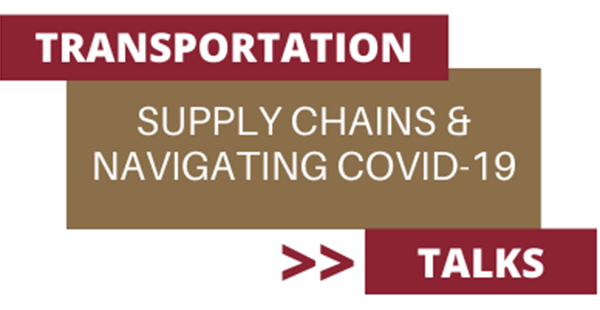
Supply Chains and COVID-19: Agility, Flexibility, and Engagement the Foundation of Navigating Change
As the country deals with the economic disruption of COVID-19 and quarantine, leaders in the supply chain sector are facing challenges that haven’t been felt since the economic downturn during the 2000s. The pandemic affected every part of the supply chain from manufacturing to warehouse operations and consumer supply to the transportation industry.
To understand the challenges and opportunities of COVID-19, The Transportation Institute at the University of Denver (DTI) created the Transportation Talks: Supply Chains and Navigating COVID-19 series to gain insight into the first-hand experiences of leaders navigating through significant change and disruption.
As part of the interview series, Arthur Adams, Jr., DTI board member and vice president of sales, supply chain and customer engagement at CSX, discussed leadership and his company’s response to the pandemic, as well as economic and social change.
“We are still thriving, we are still surviving, and the business is still as strong as it can be given the backdrop of the pandemic,” Adams said. “The pandemic in and of itself is unprecedented. It was arguably probably the largest variance that we’ve seen in volume both in terms of the decline and the uptick [during recovery in June] in any given quarter in the history of railroading.”
According to Adams, agility, flexibility, and engagement have been key to CSX and others in the railroad industry adapting to the changing world in light of the pandemic. CSX was able to build on existing continuity plans for natural disasters, etc., which provided valuable insights that leadership then used to focus on the safety, wellness, and execution strategies around mitigation and health of employees and customers. These plans helped CSX move quickly to gain a foothold during the early days of the pandemic to start addressing not only operations logistics but the changing needs of those down the supply chain.
Especially important was keeping communication lines open with customers and keeping them informed as things played out during the pandemic. CSX has implemented weekly newsletter updates, town hall meetings, and virtual engagement platforms have been pushed out to keep stakeholders informed.
“We have really doubled down on customer engagement,” said Adams, adding that personal communication is also a crucial piece of that plan.
“It’s picking up the phone. It’s leveraging Microsoft Teams or Zoom to continue with the interaction and engagement with customers as frequently as we possibly can, he said. “It’s a great way to understand what are some the more nuanced challenges they’re having at the grassroots level and then problem-solve on the fly and figure out how we move forward together. We have to do everything we can to work in concert with customers that we serve to ensure that we can be a viable solution as they look to recover in Q3 and beyond.”
And, as the railroad industry moves forward, Adams sees more opportunities to leverage the lessons of the pandemic for success. The use of technology, such as Zoom, is something he hopes to preserve as the economy and world opens up, as it allows more agility in communication, decisions, and connection.
In addition, Adams said that leaders have had to shift their strategies to encourage the potential of employees, in both professional and personal contexts, while out of the office. It’s allowed teams to engage on several different levels, and gives an opportunity for emerging leaders to step forward in the evolving world. Empathy, flexibility, agility, and the recognition that there is no longer separation between work and life, are key to facing the challenges all industries will inevitably face.
“I think the leaders of the future will possess high degrees of emotional intelligence. The workplace as we know it are shifting. We need to have the ability as leaders to lean in and recognize that the world around us is changing, and then figure out what the vision of the future should look like and race into that as quickly as we can,” Adams said.
You can watch the entire webinar with Adams, as well as others in the Transportation Talks series, on the DTI Vimeo site. Visit the DTI website for more information on the webinar series.
-
March 27, 2024
Denver Airport Spokesperson Credits her Communication Management Master’s
Ashley Forest's master's degree in Communication Management from University College propelled her career to new heights.
-
March 1, 2024
Q&A: Communication Management Program Looks Constantly Ahead
Academic Director Dr. Cindy Cragg keeps her finger on the pulse of the communications field in order to ensure the program stays cutting-edge and relevant to professionals in the industry.
-
February 2, 2024
For Great ROI, Invest in Yourself
If you’re seeking to expand your horizons, a University College credential can give you an exceptional education and help you stand out.
-
October 20, 2023
Awards for Two University College Staff and Faculty
Two members of the University College community were recognized this week for their embodiment of university excellence.